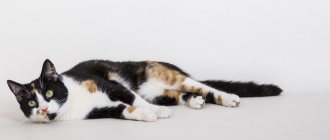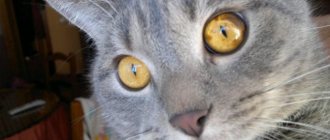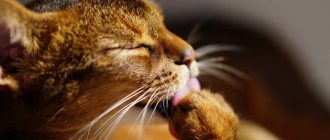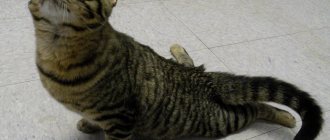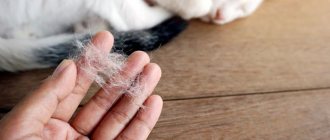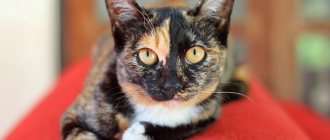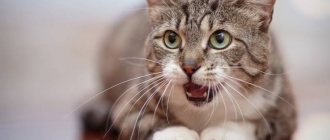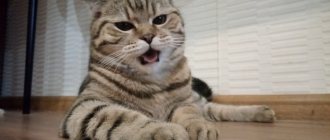I am writing this note because, when I discovered a spot on a cat, I searched for information on the Internet, but for some reason I could not find a similar photograph or specific data. So... So that those who have already encountered this problem do not scroll down in panic, I will say right away: I will not recommend a home method of treatment. The cat needs to be picked up, placed in a carrying basket and taken to the doctor.
If it is not a scratch on the nose (and the spot may look like one at first glance), then most likely it is a fungus. The problem is that lubricating the nose with antifungal agents is not at all beneficial for the cat, since the pet will simply lick or “wash off” the medicine with its paw. I didn’t experiment, although the first thing I did was run to the pet store for some kind of remedy. To which I was told that for such situations there is no lubricating medicine - it will be “eaten” by the cat. The doctor can solve the problem with an injection. So the advice was correct. And now, in order.
A cat has a black spot on its nose - 5 causes of dark spots
If black dots appear on a cat’s nose, owners should not immediately worry. Such spots may be ordinary moles that people also have. But still, when a kitten has dark or white crusts around its mouth, it is recommended to show your pet to a veterinarian. Often the problem is associated with a skin disease and requires urgent treatment. At home, it is impossible to determine why a cat’s nose darkens, but a veterinary clinic will help determine the cause through a series of diagnostic examinations.
Ways to deal with brown crusts that appear
The first thing to do is to identify the cause of the problem, and only then begin full treatment. If a crust appears on the nose due to bleeding, allergies or mechanical damage, it is necessary to wipe the nose with an alcohol solution. If after this the crust appears again, then the reason is more serious.
If a calicivirus infection develops, you will have to use a whole series of medications prescribed by a specialist. The veterinarian will identify the cause of the disease and then prescribe medications. Self-treatment of a kitten is not acceptable, because the baby’s immunity is greatly weakened, and bad medications can only worsen the pet’s general condition.
If fungal skin lesions occur, special ointments and tablets are prescribed. They must be taken until the signs of the disease disappear completely. In this case, it is necessary to take into account the individual intolerance of the components by a small pet.
Chronic rhinitis also often causes brown crusts to appear. You can fight the disease with the help of special drops, which can be found in large quantities in veterinary pharmacies. Cats are difficult to respond to such treatment, so the animal’s head will have to be pinched in order to pour the drops intended for this into the nose twice a day.
If your kitten develops skin or fungal infections, remember that they can be dangerous to humans. That is why a sick animal must be isolated from communication with people, especially children, at least for the duration of treatment.
A caring owner will always be able to notice strange brown crusts in time and eliminate them before the problem develops further. Such crusts can be associated with the development of very serious diseases, so the symptom should not be ignored.
Why do crusts appear?
Mechanical damage
A red or brown spot on a kitten's face is the result of injury. A healthy pet's nose is always slightly moist, as a result of which when a wound appears, it takes a long time to heal. If the owner is sure that the problem is related specifically to mechanical damage to the skin, then it is worth treating the affected area with antiseptics several times a day. In this way, it is possible to speed up the process of disappearance of the stain and prevent infection from entering the wound.
Veterinarians warn that antiseptic solutions are required if a weeping erosion or crust appears in the cat’s wound area, which prevents the pet from breathing normally.
Infectious diseases
If a cat's nose darkens or a light-colored stripe appears on it, this may be the result of an infection in the wound. Such a disorder can be recognized by the altered state of the pet. The kitten becomes lethargic and does not want to eat, including its favorite treats. In a severe form of an infectious disease, as a result of which a black spot appears on the nose, the following symptoms are observed:
- gagging;
- diarrhea;
- dehydration of the body.
In case of such an illness, you should not delay going to the veterinarian, especially if the cat has not received all vaccinations. An infectious disease is fraught with serious complications. A black crust that forms near a kitten's nose can develop into a rotting wound and lead to other dangerous consequences that result in the death of the pet. It is impossible to cope with the problem at home on your own, since the animal requires long-term therapy in a hospital setting.
Skin diseases
Some owners do not pay much attention to this problem, thinking that the cat simply has a dirty nose. But often the cause of the disorder is a dermatological disease of varying complexity. The source of the disease are fungi and bacteria that actively multiply. To select treatment, your pet must undergo laboratory tests to determine the causative agent of black spots in the nose area. Different groups of medications are prescribed to treat the crusts that appear. It is equally important to regularly wipe your cat’s nose with antiseptics to prevent re-infection.
Allergic reaction
Black spots on a cat’s nose or in the lip area can appear as an allergy to various irritants. In most cases, dry crust occurs due to the consumption of certain foods, as a result of which the kitten has an allergic reaction. But sometimes the problem is related to the contact of a pet with household chemicals. To eliminate stains in the nose area, you need to take antihistamines, which are purchased at a veterinary pharmacy as prescribed by a veterinarian.
Does calcivirosis affect?
A white spot or black nose in a cat sometimes appears against the background of a disease of infectious origin. The disease most often occurs in pets that have not been vaccinated. Calcivirosis is accompanied not only by a spot on the nose, but also by other symptoms:
- wounds of various sizes in the mouth and ears;
- inflammatory reaction of the conjunctival membrane;
- increased tearing of the eyes;
- damage to the joints of the cat’s limbs;
- heat;
- enlarged lymph nodes;
- labored breathing.
Veterinarians note that if a cat has calcivirosis, it is necessary to use special drops that dissolve the crusts and allow the pet to breathe normally.
Changes in indicators, as they indicate
Changes in the condition of a cat’s nose can indicate both a change in the condition of its body within the physiological norm, and the development of a serious pathology, which allows the attentive owner to consult a veterinarian in time and prevent possible complications in their beloved animal. The condition of the nose can also be influenced by external factors.
Dry nose and its causes
It is normal for a cat to have a dry nose during sleep, as well as for the next half hour after waking up. This is explained by the fact that the secretion of mucous glands decreases during sleep. If your nose continues to be dry, this is a good reason to perform thermometry.
A dry nose can also occur during stress or after physical activity; During play, the nose can change its state from wet to dry several times, since the nose tends to reflect the reaction of the cat's body to physical activity.
Heat and dry air can also cause a dry nose; under these conditions, moisture evaporates faster from the cat’s nose, and the glands do not have time to replenish lubrication. The cat will lick itself frequently in an attempt to compensate for the moisture. You need to make sure that your cat always has drinking water to replenish the lack of fluid.
With fever, the nose becomes dry and also hot for a long time; this is due to both elevated body temperature and the lack of fluid in the body that accompanies fever. Fever is an increase in the cat's body temperature above 39 °C. All cases of fever are a reason to consult a veterinarian.
Some cats are prone to dry noses due to their breed, such as Bengals.
It is worth paying attention to the discharge from the cat’s nose; Normally they are not present, and they have nothing to do with normal nasal lubrication. Exuding from the nasal passages, they stain the fur and form crusts. The cat sneezes, its sense of smell is dulled, which leads to loss of appetite. Nasal discharge should never be ignored. Thus, viral infections at the onset of the disease are characterized by mucous, transparent nasal discharge; when bacterial flora is added, the discharge becomes purulent. A mucous discharge from only one nostril may indicate the presence of a foreign body that the cat could accidentally inhale, as well as a polyp in the nasal cavity. In the presence of a tumor, discharge from one nostril mixed with blood is typical. The allergy is characterized by profuse, clear nasal discharge. In case of injury, nosebleeds may develop. The presence of nasal discharge in a cat is always a reason to contact a veterinarian.
Warm or cold: what affects temperature
First of all, this is influenced by subjective perception, since the difference in body temperature between a cat and a human is approximately 2 °C. Next are the factors discussed above that cause dry nose; because the water evaporating from the secretions of the nasal glands causes the nose to cool. The temperature of the nose and its humidity are closely related; for example, at the very beginning of a cold, when a fever begins, the nose may already be warm, but still wet. If the fever persists, the nose will become dry and hot.
There is one ominous symptom associated with the temperature and humidity of the cat’s nose. This is a wet and very cold nose. Such a nose occurs due to acute circulatory failure - shock; which may be caused by low temperature, burns, electrical shock, allergies, poisoning, injury, inflammatory disease or other reasons. Shock is necessarily accompanied by depression of the cat’s consciousness and physical activity. The mucous membranes available for inspection are pale or bluish in color; pulsation in the main arteries is weakened, ears and paws are cold, breathing is shallow. Shock is a life-threatening condition; the cat must be urgently taken to the nearest veterinary hospital with intensive care. Before transporting, call the clinic, this will ensure the readiness of the resuscitator; wrap the cat in something warm; if the cause was injury, ensure immobility during transportation by placing it on a smooth hard surface (board) on its side; monitor the cat's condition over time. It is important to act extremely quickly; cats, unlike people and dogs, resist shock very poorly.
Photo gallery about nasal discharge in cats:
A small amount of mucous discharge may indicate the onset of an infectious disease or allergy
Abundant purulent discharge from the nose indicates the participation of bacterial or fungal flora in the disease
Nosebleeds are most often seen with injuries; may occur due to poisoning by rat poison
Nose color and spots
The nose can be pigmented, without pigment, as well as with congenital pigment spots, which have a constant size, shape, color, and are covered with unchanged nasal skin.
If the nose is without pigment (pink), then by the change in its color one can judge changes in the blood flow and even the composition of the blood in the capillaries (the smallest blood vessels), which in the area of the nose are located very close to the surface of the skin; So, with a decrease in blood pressure, anemia, the nose becomes pale; with insufficiency of heart or lung function - cyanotic; with inflammation of the liver with jaundice, the nose may acquire a yellowish tint due to the increased content of bilirubin pigment in the blood; with allergies, the nose turns red. If the nose is pigmented, then such an express diagnosis is not available, however, you can pay attention to the non-pigmented mucous membranes of the mouth and eyes; getting to them is a little more difficult, but the changes will be the same. Any sudden change in the color of the cat’s nose and mucous membranes is a reason to consult a veterinarian.
In addition to congenital pigment spots, young animals may develop multiple pigment spots on the nose, as well as on the mucous membranes and abdomen. This lentigo, a non-dangerous condition, is determined by heredity. In animals over 8 years of age, dark pigment spots may appear on the nose, associated with chronic photodamage from sunlight. Cats with a non-pigmented nose are especially susceptible. Usually these spots are harmless, but it is worth paying attention to monitoring them; since in some cases they serve as a source of development of squamous cell skin cancer. The good thing is that this form of cancer develops gradually, and an attentive owner will always contact a veterinarian, and the cat will be cured. The disease usually begins with the formation of redness and scab (crusts) on the nose. Persistent crusts and redness on a cat's nose can be the initial signs of squamous cell skin cancer - this is a reason to consult a veterinarian. With the development of the disease, in the absence of treatment, the formation of erosions and ulcers is characteristic; and then aggressive tumor growth with destruction of the nose. In the early stages, the veterinarian performs surgical treatment with excision of the tumor and complete recovery; in advanced cases, surgical treatment is also possible, but it will be aimed at improving the animal’s quality of life.
Photo gallery about spots on the nose of cats:
Uneven pigmentation of the nose, characteristic of tortoiseshell cats
Manifestations of lentigo - local melanosis of the skin - on the nose. This is an individual feature of the body. There is no connection with the further development of oncopathology
At the onset of the disease, squamous cell carcinoma looks like a small ulcer covered with a scab. Unlike ordinary injuries, this wound does not heal, and the owner should be wary. If measures are not taken in time, the tumor actively grows, spreading to neighboring tissues
If the tumor has grown, then getting rid of it requires resection of large amounts of tissue. The photo clearly shows rough guiding seams. Such sutures are usually applied to close the edges of the wound in conditions of tissue deficiency. There is a fight for the cat's life
Nose shape
Breeds with shortened, flattened faces deserve special attention. These include Persian cats, as well as short-haired exotics. As a result of selection, these breeds received a pronounced flattening of the facial skull, which led to a predisposition to chronic inflammatory diseases of the upper respiratory tract. The cause is a mechanical interruption of the air flow passing through the shortened and deformed nasal passages, which leads to chronic inflammation of the epithelium. Veterinarians combine a set of diseases associated with the structural features of the facial skull in such animals into brachycephalic syndrome; and insist on mandatory regular monitoring of all cats of brachycephalic breeds (Persian, British, Scottish Fold, Himalayan and others). Representatives of these breeds often have stenosis (narrowing) of the nostrils, which is not noticed by cat owners. This is manifested by decreased activity of cats, shortness of breath after minor physical exertion, and sniffling. Veterinarians often identify this pathology during routine examinations. The treatment is surgical, plastic surgery of the nostrils is performed, and the cat is able to breathe normally. It is very important to treat your cat in the first years of life to prevent further development of the disease.
Photo gallery about the treatment of narrowing of the nasal passages:
The narrowing of the cat’s nostrils prevents the inhalation of air, which leads to shortness of breath and exercise intolerance. Surgical treatment - wedge-shaped resection of the nose - allows you to restore normal breathing. Remarkable results of surgical treatment: the cat’s nose looks great and breathes no less beautifully.
Alarming symptoms: what to look for?
If a pet's nose has turned black and various spots have formed, then the owner should not ignore this condition. When the disease is advanced, the spots spread throughout the cat’s body and lead to dangerous complications. Additionally, the cat is disturbed by the following unpleasant symptoms:
- swelling and redness of the skin;
- hair loss in the area where the spots formed;
- inflammatory reaction of the epidermis;
- multiple small pimples;
- itchy sensations;
- deterioration of the coat condition;
- peels of different colors;
- dry nose.
Calcivirosis
Calcivirosis is a dangerous viral disease of cats. In addition to the nose and oral cavity, the infection can affect the respiratory, hematopoietic and nervous systems of animals, and the digestive organs. The disease is often severe, with symptoms appearing within 1-3 weeks, and about a third of those affected die. Survivors are able to shed the virus into the environment for up to 12 months. With stress, deterioration of living conditions, infection with VLK or FIV, a relapse of calicivirus occurs. If a secondary infection occurs, the mortality rate increases to 80%.
To avoid death, you need to show the animal to a veterinarian as soon as possible.
Diagnosis and treatment methods
The therapeutic course for spots on the nose is selected by the veterinarian based on the diagnostic results. The main thing in making a diagnosis is a laboratory test to determine the pathogenic microflora that caused the rash on the face. Blood and urine tests may be required. For black spots, local treatment is prescribed, but for advanced cases of the disease, an integrated approach is required using medications from different groups.
Among the antiseptics, Miramistin is suitable for animals.
When rashes on a cat’s nose are associated with an allergic reaction, drugs with antihistamines come to the rescue. For daily treatment, antiseptics are used, such as:
When spots on a cat’s nose are caused by a dermatological disease, antibacterial agents that suppress the activity of pathogenic microorganisms are necessarily used for treatment. It is equally important to adjust your pet’s diet by eliminating fatty foods and adding more fresh food. Omega-3, 6 and vitamin supplements help strengthen the cat’s immune system and prevent the appearance of other spots. It is possible to use folk remedies, such as a decoction of chamomile or celandine, which is used to treat the cat’s nose.
Source
Wounds and allergies
Sores and crusts on a cat's nose and around the lips may be the result of an allergic reaction. Typically, such symptoms appear in response to food allergens, but damage to the skin of the nose can be caused by contact with household chemicals.
For treatment, special antihistamine drops are used. You can buy them at a veterinary pharmacy. If the allergic reaction is moderate, it is enough to eliminate the irritant for the symptoms to subside. No specific treatment is required; it is enough to avoid contact with the allergen in the future and treat the crusts with an antiseptic to prevent infection.
Black spots, dots on the cat's nose
In cats of different age groups and breeds, dark spots can either appear suddenly or disappear throughout life.
Most often, black spots and dots resemble freckles in humans. They are called acne (blackheads) or lentigo (benign pigment spots with a diameter of 0.5-1.5 mm). Mostly localized on the nose, chin, ears, lips, paw pads.
Important! As a rule, black dots do not have a negative effect on the pet’s health and do not signal any malfunctions or pathologies.
In most cases, black spots on the nose, lips, and ears appear in adult cats, especially in animals that walk outside. Note that dark spots on the nose are clearly visible if the cat’s earlobe is light pink.
Why did a domestic cat become infected with a fungus?
A domestic cat can become infected not only from other animals, but also from street clothes and shoes. The main character of this story really liked to sniff the owner's things after the street. He loved to lie on the threshold, smell shoes and bags... In general, he managed to collect all sorts of microscopic nonsense.
But this does not mean that you should shy away at the sight of street animals. Some kind of infection will still get on things one way or another. You walk on the ground, not fly through the air. It’s just that even absolutely domestic animals need to be vaccinated as well, and also shown to a veterinarian if they show signs of poor health. Not to mention those that have access to the street.
Causes of black, dark spots on a cat's nose
Black dots on a furry pet’s nose appear for a variety of reasons (physiological, pathological), among which are:
- breed, genetic predisposition;
- exposure to sunlight;
- metabolic failures;
- hormonal imbalance;
- errors in feeding, improper care;
- endocrine pathologies, chronic diseases;
- sudden change in diet;
- stress, emotional turmoil;
- violation of hygiene rules, feeding from dirty bowls;
- tendency to allergies;
- a sharp change in diet, switching to new foods;
- dermatological problems (contact, chronic, atypical, infectious dermatitis caused by viruses, fungi);
- mycoses;
- problems in the functioning of the liver and pancreas.
As a rule, the mechanism for the appearance of black dots on the nose of cats is associated with an excess, enhanced production of the melanin pigment (responsible for the dark color). Spots on the lobe most often appear with age and are very rare in young kittens.
As for breed predisposition, black spots on the nose can be found in Sphynxes, Devonrexes, Abbishinos, Siamese, Persian, and Himalayan cats.
When should an owner sound the alarm?
Black dots on the nose that have developed for pathological reasons, due to hormonal, systemic disruptions in the body, may be accompanied by the following symptoms:
- itching, scratching on the face;
- restless behavior;
- the appearance of a skin rash, bald patches on the body;
- poor coat quality;
- dry nose;
- unstable temperature;
- decreased activity;
- refusal of food;
- increased thirst;
- skin inflammation;
- the appearance of scabs, dry crusts on the nose;
- swelling.
If dark dots, spots of different diameters, increase in size, are distributed throughout the animal’s body, ulcers are noticeable, or other signs that are not typical for a healthy cat, it would be a good idea to show your pet to a veterinarian, since such symptoms may signal the development of neoplasia and skin cancer.
Malignant pigment spots have a dirty yellow, brown, dark brown color with a reddish tint, and uneven edges. They may protrude somewhat above the surface of the skin. In severe cases, blackheads can spread throughout the pet's entire body.
What to do if your cat has black spots on his nose
If the dark spots periodically disappear and appear, but the cat feels fine, do not worry. Perhaps the appearance of black dots on the nose is caused by the pet’s exposure to the sun or other harmless factors (genetic predisposition, change of diet).
At home, you can wipe your cat’s nose with hydrogen peroxide 2-3 times a day. The solution is diluted 1/1 in water. You can use antiseptics (miramistin, chlorhexidine), decoctions of medicinal herbs (calendula, chamomile).
In all other cases, if there are obvious signs of illness, take the cat to the clinic for examination.
Source
The kitten has black nose wings. Help make a diagnosis!
Only registered users have the ability to start new topics. Register and log in to the site by entering your username and password on the right side of the window, and you can start a new topic.
Before visiting the forum, read the topic: “How to properly consult a veterinarian,” as well as the list of answers to frequently asked questions, this will help you save your time and get an answer to your question faster. Pay special attention to the document: Symptoms of animal diseases. Perhaps in your situation you cannot expect an answer on the forum, but you need to urgently call a doctor or take the animal to a veterinary clinic!
Before joining the forum, read the following sections, this will help save your time and quickly get an answer to your question:
Attention! Pay special attention to the document “Symptoms of Animal Diseases”. Perhaps in your situation you cannot expect an answer on the forum, but you need to urgently call a doctor or take the animal to a veterinary clinic!
Source
Infectious diseases
If a cat has black crusts on his nose that do not heal for a long time, the cause should be sought in infectious diseases. Associated symptoms of infectious diseases:
In this case, the animal may refuse to eat and be lethargic. Particularly severe forms of infectious diseases are accompanied by vomiting, diarrhea, and dehydration.
Cat infections are very dangerous, especially if the animal does not have all the necessary vaccinations. Black crusts on the nose are one of the most harmless symptoms; in severe cases, infectious diseases can lead to the death of the pet. You cannot try to cure the cat yourself; you should take the animal to a veterinary clinic. This may require long-term hospital treatment.
What to do if you notice black spots on your cat's nose?
As much as you love your feline companions, it's easy to worry about any new thing on their faces, from crusty eyes to nasal discharge. Blackheads often appear on your cat's nose, and this can be a cause for concern. So, have you ever wondered what that black thing is on a cat's nose?
The black stuff on your cat's nose is caused by boogers, mucous nasal discharge from dust, or scabs. Small spots of dried blood are signs of a bacterial infection. Feline herpes or lentigo can also cause discoloration of the nose.
It's good that you're paying attention too: cats' tears and other things on their faces can be an indicator of their health. Sometimes this discharge tells you that your cat is healthy, and sometimes this discharge can be the first sign of a problem and a sign that it is time to see a veterinarian.
Photos of cats with crusts on their noses
Infectious diseases
A contagious disease of the upper respiratory tract is calcivirosis. This formidable pathology affects only representatives of the cat family; the virus can lead to the most disastrous consequences - the death of the animal. Pathogenic microorganisms spread throughout the external and internal organs of the pet, filling the eyes, nose, mouth, throat, and lungs. Black crusts on a cat's nose may indicate the penetration of a dangerous infection into the body. In addition to the above sign, the following symptoms can be traced:
- visually visible sores on the tongue, gums;
- nasal discharge (snot);
- ulcers on the mucous membranes with liquid contents;
- profuse salivation and lacrimation;
- apathy towards the environment, lethargy;
- fever;
- lack of appetite;
- swollen lymph nodes;
- pain in the joints, and, as a result, limping.
Causes of black spots on a cat's nose
There are many things that can happen to your cat that can cause a black spot to appear on its nose. Even small scraps of black fabric from one of their favorite toys may look like something you need to worry about until you take a closer look.
You should also take a close look at any black things on your cat's nose if you usually wear black clothes or have dark furniture or carpeting. Lint and dust from these dark sources can easily get into your cat's nasal lining and cause dark discharge.
This is the mucous membrane that does its job and protects your cat's respiratory system. But if it's a common occurrence, consider vacuuming or scrubbing away possible sources of lint, or even keeping your cat away from the source. This is because black nasal discharge can sometimes be more serious, and you don't want to miss signs of illness due to lint.
Another less dangerous cause of black spots on your cat's nose could be a small scratch on the surface of the nose and the scab has dried out. If you have multiple cats at home, it is not uncommon to find small scratches on your cat's face. Cats are territorial and will often use their claws to force another cat to retreat if hissing and fluffing their fur doesn't help.
What should a healthy cat's nose look like?
Externally, the structure of the nose is divided into the apex, dorsum, root and sides. The tip (lobe) of the nose is not covered with hair and has two nostrils. The nose is the initial section of the respiratory system. The nasal cavity is divided into two parts by a cartilaginous septum; the paired nasal passages have a tortuous course; they are covered with mucous membrane. Passing through the nasal passages, the air is moistened, warmed, partially cleared of microscopic inclusions, bacteria and viruses, and then used by the cat for breathing. The nasal passages block the incoming air flow; the odorous substances contained in it dissolve in the mucus covering the epithelium and become available to the olfactory receptors. A cat's sense of smell is 15–20 times more acute than a human's. The nasal cavity communicates with the space of the paranasal sinuses, which are located between the plates of the flat bones of the skull and also contain olfactory receptors in their mucous membrane. Inflammatory diseases of the nasal cavity are often complicated by inflammation of the paranasal sinuses. The nasal cavity communicates with the external environment through the nostrils; with the pharynx - through special openings - choanae; with the eye socket - through the nasolacrimal duct.
The appearance of the unpigmented nose is normal: pink, uniform color, the skin of the nose is without damage and slightly shiny with moisture, there is no discharge from the nostrils, the hair around the nose is clean
The cat also has an additional organ of smell called Jacobson's organ; It is located in the area of the upper incisors above the palate. The cat uses it by inhaling air through its mouth. Scientists suggest that cats prefer to smell pleasant smells using their nose; and unpleasant ones - with the help of Jacobson's organ.
The appearance of a cat's nose depends greatly on its breed and color. If you compare side views of photographs of representatives of different cat breeds, the difference in nose length can reach several centimeters. The shortest noses are characteristic of Persian cats, as well as British and Scottish folds. The shortened nasal passages of these breeds make them susceptible to infectious diseases of the upper respiratory system.
The color of the nose can change with age and also depend on the ambient temperature. For example, it is noted that as the temperature decreases, a pigmented nose becomes darker, and a light-colored nose becomes lighter. With age, the color of the nose may become darker. The color of the nose usually harmonizes with the color of the muzzle, maybe several colors darker. In cats of some colors, for example, tricolors, there are congenital pigmentation spots on the nose.
The presence of a dark birthmark with clear boundaries, constant shape, size and color against the background of non-pigmented skin of the nose, the skin above the birthmark is not changed - this is the norm
The nasal mirror of a healthy cat feels cool and slightly moist to the touch; the moisture in the nose is ensured by the work of special mucous glands; mucus is quite thick and helps to capture, retain and dissolve odorous substances, facilitating their contact with the olfactory receptors. Mucus also serves as a kind of protective lubricant for the delicate nasal mirror; If there is insufficient mucus production, cracks, crusts, and wounds may appear on the nose. The water contained in the mucus evaporates from the surface of the nose, cooling it and causing a feeling of coolness when touching the nose. Drying of the nasal planum is very painful for a cat and significantly reduces its sense of smell. The fur around the nose is normal - dry and fluffy, with no traces of discharge on it. The cat breathes freely and almost silently through its nose.
Additionally, the moist nasal speculum partially takes over the function of thermoregulation, helping to cool the cat's body.
This is simple lentigo
Another possible cause is simply your cat's nose being discolored. Lentigo is the development of small areas of hyperpigmentation on your cat's skin and it is a common occurrence around your cat's nose and mouth, if a black spot is adjacent to your cat's nose and looks like part of the skin, congratulations, your cat essentially has a new freckle.
Lentigo is not dangerous and does not affect your cat's health in any way. Once you notice one lentigo spot, you are likely to see more. The spots look like freckles or age spots; your cat will likely get more, but don't expect any side effects from the spots.
Lentigo - a feature of saffron milk caps
Since lentigo is a genetic disease, it is associated with color genes. There is no evidence, but observations show that freckles are more likely to form in cats and cats with a red color. Moreover, freckles begin to form in adulthood and old age.
Cats of red, red, tortoiseshell and fawn colors are prone to lentigo. Obviously, all these varieties have the same color gene. Cream and silver cats also sometimes have freckles, but this is the exception to the rule.
The first lentigines usually form on the lips and gums, and then on the nose. The process begins when the cat is 1–3 years old. As your cat ages, freckles appear on other parts of the body and increase in number and size. After appearing on the nose, the spots “migrate” to the area of the ears and paw pads.
More serious reasons
There are several more serious reasons for a black spot on your cat's nose. Sometimes a bacterial infection can cause your cat's mucous membranes to change color, in which case your cat will likely need treatment for a respiratory infection.
In this case, the black color may be blood again, but this is usually due to irritation of the nose and respiratory tract and may be a sign that your cat is in trouble.
© shutterstock
Another reason is feline herpes. Although it may seem incredible, the good news is that many cats are completely unaffected by herpes and cannot be infected with the herpes virus.
However, if one of your cats has herpes, chances are every other cat in your home also has the virus. It is important to prevent uninfected cats from coming into contact with infected ones, including keeping the cat indoors only after diagnosis.
Herpes does mean that you may have to wipe off the discharge, and your veterinarian may prescribe some cleaning products to keep the problem under control.
Of course, if you are unsure why your cat is having nasal discharge (of any color), especially if the discharge is sudden or more than usual, you should take your cat to the vet. Taking her to the vet is the best way to make sure your cat remains safe and healthy.
As a general rule, your cat's nose should be clean and dry. Some cats have wet noses, but this is not very common. If you notice changes in your cat's nose, it's best to get a physical exam just in case.
